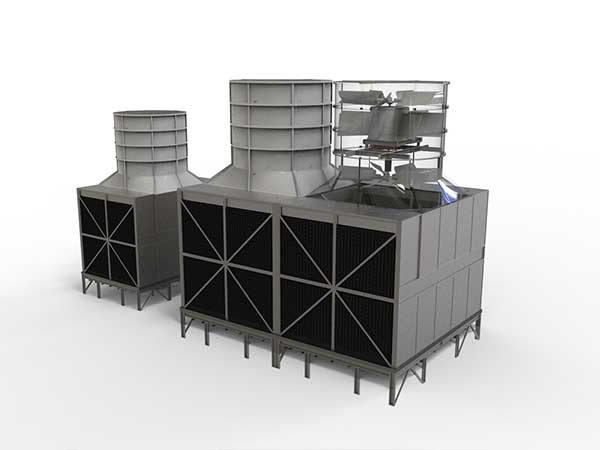Cooling tower noise reduction without affecting efficiency
Author:Trlon Views: Time:2020-08-27
Cooling tower noise control and control methods can be divided into two ways:
1. Active noise reduction
In the cooling tower production or noise control, fully consider the causes and characteristics of cooling tower noise, tailored to the case. On the premise of guaranteeing the technical parameters needed by the equipment, the equipment is optimized and upgraded, and the noise source is suppressed and rectified. Its biggest advantage is not to affect the cooling tower cooling effect, does not increase the floor load, various frequencies of noise can be effectively suppressed, beautiful appearance, expand the use of urban environment space. My company is using the noise reduction technology.
2、Passive noise reduction
The installation of sound barrier outside the cooling tower can also reduce the noise level of a to a certain extent, but the disadvantage is that the ventilation of the cooling tower will be reduced and the heat exchange efficiency of the cooling tower will be reduced, in terms of noise suppression, the low frequency or very low frequency attenuates very little, which makes the air-conditioning system prone to high-voltage trip, equipment failure, energy consumption increase, etc. , moreover, passive noise reduction is often restricted in the reconstructed environment space because of the relatively large area required for installation. An acoustic company through noise enclosure, but still low-frequency noise disturbing people, more serious is due to the cooling tower ventilation is not enough to lead to poor cooling effect, forced to remove most of the Muffler Fin.

The huge steel structure adds hundreds of tons of weight, and the iron-barrel enclosure finally reaches the a-sound level, but the low-frequency noise reduction effect is still extremely poor. At the same time, the excessive enclosure will affect the ventilation of cooling tower and reduce the heat dissipation efficiency, which will lead to the increase of power consumption and energy consumption of equipment, and affect the cooling effect.
e6iCooling tower noise reduction treatment manufacturerOverturning the traditional cooling tower noise reduction technology
1、Ultra-quiet fan
The fan is aluminum alloy design, aviation-grade aluminum alloy blades, wheels using metal mold molding, blades with stainless steel u code connection, stepless adjustment of fan angle, surface spraying anti-corrosion treatment, with high pressure, large air flow and so on. The utility model has the advantages of good aerodynamic performance, high strength and corrosion resistance, and can meet the technological requirements and improve the efficiency of the device by changing the positioning angle of the blades. The biggest feature of the fan is to break through the traditional cooling tower of 4,6 or 8 blades, the technology for the National Invention Patent, a cooling tower on the installation of multi-layer multi-blades, conventional configuration of 21 ultra-quiet blades, the effect of noise reduction is achieved under the condition that the air volume is satisfied.
2、Maglev Power Platform
The supporting frame of the power system of the cooling tower is set inside the cooling tower, and the suspension type installation is adopted to completely separate the running parts from the tower shell, so that the noise generated by the operation of the cooling tower and the resonance of the Tower Shell are eliminated, the sound pressure value of the external propagation of the operating noise is further reduced. At the same time, the sound environment pollution caused by the sensitive points in the downstairs room can be avoided by the way of structure transfer.
3、Internal sound absorbing board
The plate is made of glass fiber reinforced plastic and its thickness is 2.0 mm. According to the sound transmission law, the plate wall has holes to absorb the sound inside the tower body and is installed on the side plate of the cooling tower.
4、Silencer
A Muffler is installed at the air outlet of the Cooling Tower. The material of the Muffler is made of glass fiber reinforced plastic. In order to reduce the influence of low-frequency noise on the acoustic environment quality, the exhaust louver adopts a 30 ° angle to direct the hot air to the opposite direction of the "boundary" . Not only reduce the phenomenon of heat reflux, while reducing the visual pollution of households.
5、Inlet Grille
A silencer is installed at the air inlet of the cooling tower. The material of the Silencer Grille is made of glass fiber reinforced plastic. The outlet louvers direct the hot air in the opposite direction of the "boundary" at an angle of 45 ° to further reduce the effect of the wind resistance caused by the intake of fresh air from the cooling tower. Not only reduce the phenomenon of heat reflux, while reducing the visual pollution of households.
6、Low Noise Motor
Specially designed for the special requirements under the cooling tower environment proposed by Turing Company, it adopts the special motor of fully enclosed self-cooling cooling cooling tower with low noise, which has good waterproof performance and low noise, the utility model can meet the special requirements of the cooling tower for the motor under the working conditions. Convenient replacement, disassembly, maintenance, trouble-free operation time is long, with high efficiency, high protection level (IP55) , high insulation level (F level) , etc. , the utility model can run continuously with low energy consumption for a long time under the humid and hot environment of the Cooling Tower (the normal service life is not less than 20 years) .
7、Speed reducer
Equipped with Japan NTN HIGH-PRECISION BEARINGS, upper and lower end are equipped with insurance oil seals, waterproof performance, to avoid water erosion bearings. Disc-shaped steel support and plate pulley design, compact structure, with static balance check, smooth operation, low noise.
e6iCooling tower noise reduction treatment manufacturer Article Address:https://www.trlen.com/product/133.html









